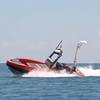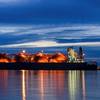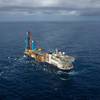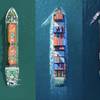Camacho Returns to His Roots
While the movie provides an interpreted portrayal of those events, no rendition could possibly compare it to a first-hand account. Having lived through the attack as an eight-year-old boy, Retired Admiral Dick Camacho, remembers the day as one that left many people living in fear. Camacho, who now serves as senior vice president for Government Business at United States Marine Repair (USMR), recalls the drama and loss that occurred during "wartime Honolulu." Camacho also recently has added, ironically, the responsibility of ship repair yard Marisco to his watch. Located on the site of the former Pearl Harbor Naval Yard, USMR recently signed an agreement to acquire Marisco. Mere proof that Camacho has once again "returned to his roots."
The acquisition of Marisco by United States Marine Repair (USMR) is expected to be completed soon. As one of two full service shipyards in Hawaii, USMR believes Marisco will provide a strong, local presence to help it win government and commercial ship repair.
With the U.S. fleet not getting any younger, government financial support dwindling, and a backlog of ships waiting to be repaired for deployment, the acquisition may be the first step in helping to ensure that the needs of the U.S. fleet are met. With USMR's family of shipyards located in the hubs of San Diego, Calif. and Norfolk, Va., the acquisition will add another strategic locale to USMR’s well-positioned facilities, as well as serve the need for additional surface ship work on cruisers and destroyers home ported in Pearl Harbor.
While Camacho admitted that there is still a lack of funding to support proper levels of ship repair operations, he noted that Congress is set to provide supplemental funding of approximately $400 million (evenly split between both coasts), to help achieve full readiness in 2001. While this alleviates the fleet's financial problems temporarily, Camacho feels "that it's wrong to ask for a supplemental (funding) every year."
Which lends to a question that has been asked for the last few years: When will the Navy's needs be adequately funded? According to Camacho, "Money will be funded through advanced planning, which will thus affect all major home ports."
While Marisco's work will focus on commercial and Navy work, the bulk will lie in the commercial realm, as the Hawaiian ship repair industry does not attract a large portion of Naval work. Camacho plans to focus on building up the yard's skill base by tapping local capabilities.
"Our first effort will be to utilize the local labor base," Camacho said. "From there we will tap the mainland and eventually the rest of the USMR yards." He added: "Our main concern is to develop a local base while meeting customer's needs.
Camacho plans to adhere to this promise by seeking out local talent, which in turn will not only provide an added number of jobs for the city, but a boost in its economic status as well. "We'll buy materials from local ports and what we can't get locally, we'll purchase from west coast vendors," he said.
Pearl Harbor Revisited
Interestingly, Camacho has returned to his Hawaiian roots two times since leaving the war-torn city in the 1940s. Holding strong ties to the area on both a nostalgic and historic level, Camacho, who served a 30-year tour of duty as the commander of the Pearl Harbor Naval Shipyard, recalls the days when his father worked in the yard's machine shop at the height of the U.S. involvement in WWII. He remembers the night of the attack, which marked the U.S. entry into the war, and how his father did not return home for almost two days. As a yard employee, the elder Camacho worked round-the-clock shifts putting out fires and assessing damage control in order to salvage what was left of the Naval Shipyard.
"My family arrived in the islands in the late 1870's on the first ships from the Azores," said Camacho, whose family was active in raising coffee on the Big Island and on the sugar plantations on Oahu. "My dad went through the machinist apprentice program at Pearl Harbor and was supervisor in the machine shop on December 7, 1941 when WWII started."
Waiting for his father's safe return, Camacho remembers looking out from the second floor window of his parents house as shells exploded all over downtown Honolulu. Fearing that an invasion was imminent, Camacho and his family would be forced to stay in the basement of their homes, which was also attributed to downtown Honolulu's Martial Law, which was established in response to the wartime activity — residents were forbidden to leave their homes after dark as a result.
Camacho always has had a strong interest in the Navy, which helped lead to his decision to attend the University of New Mexico — Albuquerque, via the Naval Reserve Officers Program, where he graduated with a degree in Naval Engineering.
From there, Camacho went on to attend the Navy's post-graduate school in Monterey, Calif. — where he picked up a degree in Electrical Engineering. He also managed to fit in courses at Harvard Business School.
His Naval career began as a line officer, and eventually brought him to Charleston, S.C., where he served as the Commander of the Naval Shipyard there. Camacho then went on to serve what would be the first of two tours at the Pearl Harbor Naval Shipyard. On returning to his "home base" Camacho was taken aback by the changes that the yard had underwent since his time there. While everything obviously has been replaced since WWII, Camacho could detect the remnants of the time and was overcome by a sense of nostalgia as he walked through the area of the yard that housed the former machine shop where his father spent so many hours. During his tenure at the Pearl Harbor yard, Camacho played a dual role as both the yard's Commander and Supervisor of Shipbuilding, directing work performed in the private sector shipyards.
In 1986, he took on his current position in strategic planning at Southwest Marine in San Diego, working to ensure that all USMR shipyards meet all requirements — ultimately leading up to his current role at Marisco.












